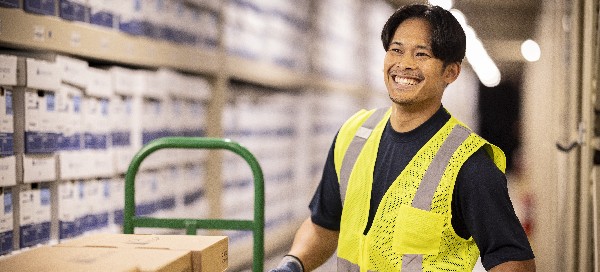The future of data centre sustainability
As sustainability initiatives are becoming increasingly prevalent, data centres are rising to the challenge. Here’s a look into what the future holds for data centre sustainability.

While data centres serve an important role amid organisational data transformation to ensure that sensitive records are securely stored, processed and made readily accessible, they are prone to significant energy consumption. If not properly managed, data centres can have a significantly negative environmental impact.
It’s for this reason that data centre providers worldwide and associated regulatory bodies are becoming increasingly focused on implementing more sustainable and energy-efficient practices. Data centre decommissioning is one area where sustainable dispositioning practices can make a significant positive impact. Let’s explore what the future holds for data centre environmentalism and the role of data centre decommissioning within a sustainable future.
The environmental impact of data centres
As of 2023, data centres are responsible for approximately 1% of global energy-related greenhouse gases, with less conservative estimates reaching 3%.
To support sustainability goals, data centre operators must employ a new approach to hardware lifecycle planning and management – from design to decommissioning to redeployment and reuse. Full racks can be reused and redeployed externally. Millions of kgs of equipment can be kept out of the waste stream. That’s circular data centre thinking – and it’s how IT organisations can optimise the value of their assets and the total cost of ownership (TCO) for their entire data centre operations.
Furthermore, the rise of certain domains — such as Cloud Computing and IoT, among others — has notably exacerbated the issue of unsustainable practices.
While computing servers themselves are a primary energy consumer, the cooling systems required to maintain the optimal temperature of data centre infrastructure are, inconspicuously, likewise a major contributor. Although these systems are necessary to prevent servers and other hardware from overheating, inefficiencies have shown to lead to substantial energy waste.
Hence, effort is being put into improving not only the energy efficiency of cooling systems but also the overall sustainability of data centre operations more generally. At Iron Mountain, for example, we have various ESG initiatives in place to increase sustainability, such as:
- Iron Mountain set a goal to use 100% clean electricity, 100% of the time in its data centres by 2040, becoming the second company in the world (in addition to Google) to adopt this aggressive strategy.
- In 2021, Iron Mountain became the first to construct a BREEAM certified data centre in North America, and is committed to seek BREEAM certifications for all new data centres by 2025
- Our goal for our data centre operations to be climate neutral by 2030, and to achieve net zero GHG emissions and zero waste operationally by 2040.
These initiatives — and the sustainability initiatives of other data centres globally — are fundamentally aligned with the standards set out by relevant industry leaders and governmental bodies, orchestrating a cohesive, systematic and quantifiable approach.
The role of data centre decommissioning in sustainability
Data centre decommissioning is the process of securely disposing of retired data centre equipment. Commonly disposed of equipment includes servers, storage devices and networking hardware — provided they are either no longer of essential use or the organisation is able to do without.
Data centre operators are called upon to improve the sustainability of their enterprises’ investment in IT hardware assets. Optimization can be accomplished by properly recycling assets or by selling fully sanitised hardware in secondary markets. Circular data centres are the root of the global circular IT hardware industry, valued at $4.5 trillion today.
eWaste, which refers to electronic waste, has arisen as a pressing environmental concern when it’s in excess or disposed of improperly. When eWaste is exposed to heat, it releases various harmful chemicals that, when emitted at scale, are of significant environmental harm. Naturally, in our age, the use and dispension of electronic devices have become increasingly prevalent, and with it, the need for responsible, data-informed eWaste management has grown rapidly.
The proper disposal and recycling of servers, storage devices, networking hardware and other relevant infrastructure minimises the risk of electronic waste releasing harmful chemicals and ending up in landfill space, which is becoming notably scarce.
Resource conservation, in the context of data centre decommissioning, refers to the efficient use of materials and energy during the retirement and disposal process — playing a significant role in reducing the carbon footprint associated with e-waste disposal. Specifically, resource conservation in data centre decommissioning — through techniques such as reusing, refurbishing and recycling hardware components — extends the lifespan of equipment and reduces the demand for new resources.
One of the key constituents of resource conservation, among others, is the identification and salvage of infrastructural components that are still functional or can be refurbished. This, in turn, not only reduces the need for new manufacturing but also saves energy and raw materials. Furthermore, when equipment reaches the end of its lifespan, recycling can extract valuable materials that can be used in the production of new hardware or other products. Another way that resources can be conversed is through modular and scalable designs: Data centres are moving toward modular and scalable designs that allow for more efficient use of resources. This approach facilitates data centre operators to expand their capacity as needed, reducing the construction of entirely new facilities.
More broadly, sustainable data centre decommissioning aligns with the principles of the circular economy, where resources are kept in use for as long as possible, and waste, in turn, is reduced. Even beyond its ESG benefits, circular data centre decommissioning works to reduce the total cost of ownership of IT hardware through value recovery on the secondary market.
As we look forward to a more sustainable future and the role data centres play in that, data centre decommissioning — and its associated best practices — will be a piece in the wider puzzle, helping data centres and their cross-industry clients reduce their environmental footprint.
Beyond data centre decommissioning: Data centre sustainability practices
Beyond data centre decommissioning, there are several other key data centre sustainability practices that are meeting and evolving to mitigate their ESG impact:
Renewable energy adoption
Waste heat recovery
More generally, data centres are continually engaged in improving the energy efficiency of their infrastructure. This oftentimes includes optimising server configurations and adopting more energy-efficient hardware. Notably, many are also implementing advanced cooling technologies, such as liquid cooling and free cooling, which rely on natural environmental conditions to maintain appropriate temperatures.
Furthermore, we’re expecting artificial intelligence (AI) and machine learning (ML) to play a more integral role in a sustainable future for data centres. These systems are able to facilitate data centre management with predictive analytics, helping optimise resource utilisation and, in turn, reduce energy consumption. By analysing vast datasets generated by data centre operations, AI and ML algorithms can predict where maintenance is needed, adjust cooling systems in real-time and optimise workload distribution across servers to minimise energy consumption.
With all that said, given the relative infancy of ESG initiatives and its associated systems and technologies, data centres are expected to continue evolving in their sustainability practices in the coming years, continually developing new technologies and infrastructure to accommodate environmental-friendliness.
Iron Mountain’s data centre decommissioning capabilities
Up against an immovable eight-week deadline, a client of ours — a health-tech leader — needed to securely dispose of legacy data-bearing, on-premises servers and migrate their current data centre operations to a private cloud, hosted from a new data centre in the United States. Partnering with Iron Mountain ensured a secure chain of custody and the environmentally responsible disposition of old server drives, while providing certificates of recycling.
The results? Freed from dismantling and wiping old hardware, the company’s IT team turned their attention to data migration, system shutdowns and other priorities, ensuring the company relinquished the property and met its legal commitments to the new owners on time.
Of our partnership, the client’s spokesperson said, “The ITAD service meant we didn’t have to needlessly tie up resources and could take care of more pressing building closure and cloud migration tasks.” To learn more about this case study, click here.
As leaders in data management, storage and decommissioning, Iron Mountain has the capacity to retire or move your data-bearing IT infrastructure in a manner that is secure, environmentally responsible and compliant with regulatory requirements. No matter the size or scale of your operations, we can ensure the proper management and/or disposal of your data centre assets.
To learn more about Iron Mountain’s data centre decommissioning service, click here. Or, click here to receive a free quote today!
Elevate the power of your work
Related resources
View More Resources
The Sentencing of Records

